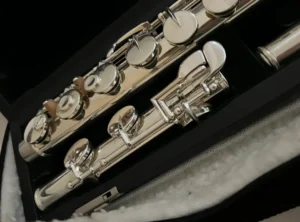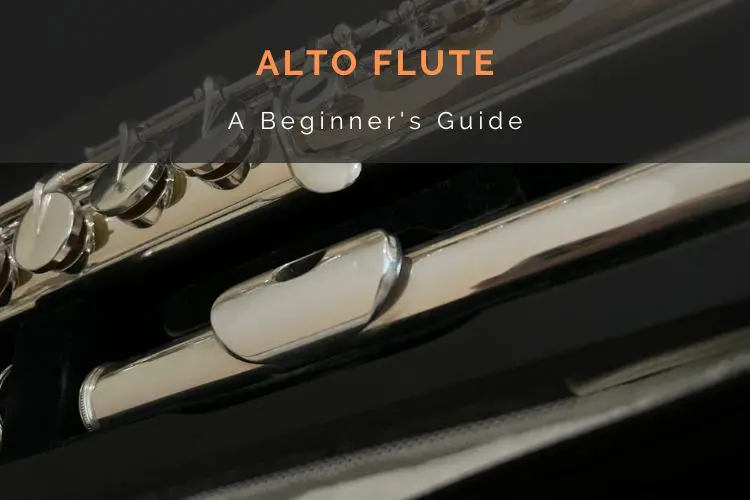You’ve been playing the C flute for a while, and you love the sound of the low register. So you start to wonder if it’s time to try the alto flute.
The alto flute is a relatively new member of the flute family. However, it sounds amazing and can be a great next step for flute students.
Read on to learn more about this low flute.
What Is the Alto Flute?
The alto flute is a member of the western concert flute family. It’s the only common flute that’s not in the key of C. Instead, it’s in the key of G, so it sounds a perfect fourth lower than written.
Luckily, most composers will transpose the alto flute parts accordingly. The fingerings for the flute and alto flute are the same for all of the written notes, so you don’t have to learn a new set of fingerings.
Since it sounds lower, the alto flute is also longer and has a bigger bore. That can make it difficult to reach the keys, which is why many players use a curved headjoint. I use a straight headjoint, but I made sure to buy an alto flute with ergonomic left hand keys that are easier to reach.

How It Compares to Other Flutes
The alto is a fourth lower than the C flute, while the piccolo is an octave higher and the bass flute is an octave lower. Of the four, the bass flute is the only one that’s larger than the alto.
If you prefer the low register of the C flute, I’d recommend learning the alto flute next. It’s a bit tricky at first, but you can enjoy more of the lower notes without as much extra weight, such as with the bass flute.
Alto Flute History
Rudall Carte & Co was the first flute company to make an alto flute (known as the Bass Flute in G at the time). A few composers used it in orchestral works, such as Gustav Holst in The Planets and Igor Stravinsky in The Rite of Spring.
More recently, the alto flute has become a staple of the flute choir, which consists of C flutes, piccolo, and bass flutes as well. The alto flute also has a growing number of solos written for it, though the repertoire is still much smaller than that of the C flute.
Why Play the Alto Flute
A growing number of flute players are starting to learn the alto flute. The instrument extends the range of notes you can play, so you can explore more music.
Here are some of my favorite reasons to play the alto flute.
Improve Your Low Register
Because the alto flute plays lower than the regular flute, a lot of what you’ll play on the instrument is in the low register. This forces you to work on your embouchure to produce those lower notes.
Of course, that can help you get a good sound on your alto flute. However, I’ve found that it also helps me play better in the low register on my C flute.
The lower notes of the flute can sound very warm and rich. If you’re struggling to get a good tone down there, trying an alto flute might help.
Build Your Stamina
The standard C flute weighs about 1.09 to 1.24 pounds, depending on the materials. An alto flute weighs about 2.26 pounds on average, about twice as heavy. Playing the larger flute can help you work on your upper body strength.

You also have to use more air to produce a sound on the alto flute. I’ve found that working on these things has helped me play my various flutes.
Access More Repertoire
Playing the alto flute also allows you to play more music. Right now, there isn’t a ton of solo music for the alto, but the repertoire is slowly growing.
As far as ensemble parts go, there are a few orchestral works that use the alto flute. Famous examples include The Planets by Holst and The Rite of Spring by Stravinsky.
The alto flute is also a standard member of flute choirs and flute orchestras.
I’ve played alto in that setting for a few years. I like to think of it like the viola of a flute choir since it’s between the C flute and bass flute (like the violins and cellos).
Popular Alto Flute Solos
Some popular solos for the alto flute include Steeples in My Soul by David Bennett Thomas and Two for Two by Katherine Hoover.
A lot of unaccompanied works for the C flute work on the alto flute as well, including the 12 Fantasias by Telemann.
Best Alto Flutes
If you want to try the alto flute, you need a good instrument. I haven’t seen a ton of knock-off alto flutes, or at least not as many as knock-off C flutes. But they exist, and they could hold you back from getting a good sound and response.
Consider the following alto flute models.
Pearl 201
When I decided to buy an alto flute a few years ago, I settled on a Pearl 201.
Specifically, it was the 201S since I went with a straight headjoint. But you can also choose a curved headjoint or both headjoint styles.
This model is all silver-plated except for the lip plate, which is solid silver. Like most alto flutes, it has a C footjoint so can play down to a sounding G3.
I love this model for the most part. Unfortunately, some of the lowest notes sound a bit flat compared to the rest of the range. However, I love how it has an ergonomic left hand so that my hand and arm don’t have to stretch as far.

Trevor James
Trevor James alto flutes are some of the best on the market, at least for their price. I got to try a silver-plated model from them a few years ago, and it sounds great. More recently, I tried their newer copper alloy alto flute.
Both models sound nice and warm, and the copper is even richer. Though I do play a rose gold plated C flute, which contains copper, so that’s probably part of why I liked it.
These models come with an ergonomic left hand, and you can choose a straight or curved headjoint or both. If you have a lot more money to spend, you can even get them fully bejeweled in different colorful patterns, but that’s not necessary.
Jupiter
When I was in college, I got to try a couple of school-owned alto flutes. One of them was a Jupiter alto flute, and it worked well. The model is silver-plated, but it doesn’t have an ergonomic left hand.
That makes it hard to reach the left hand keys, especially with the straight headjoint. It doesn’t come with a curved headjoint, but you may be able to buy one and have a tech fit it to the flute.
The Jupiter model is a fantastic choice if you’re on a budget. You can get a good sound out of it, and it’s one of the most affordable alto flutes on the market.
Yamaha
I also got to play a Yamaha alto flute during college. This model uses a gold brass alloy for the headjoint and body. That material allows you to get a very warm and dark tone, which is perfect for the alto flute.
Like many other altos, this one has ergonomic keys for the left hand. You also get to choose between a straight and curved headjoint. It even comes with both, which is nice if you want to share the alto flute with other players, so you can each use the headjoint you prefer.
Sadly, this alto flute is significantly more expensive than other models. I’d only recommend it if you’re serious about the instrument or are buying it for a school or group.
FAQs
If you’re still curious about playing the alto flute, you probably have some questions. Here’s what you need to know about this instrument.
Is the alto flute hard to play?
The alto flute can be hard to play at first. It’s larger and requires more strength and air to play, but with practice, playing the alto flute can get easier.
Is a straight or curved headjoint better?
Neither headjoint style is always better. You should try both to see which is more comfortable for you.
And while some people say it has to do with your height, your arms have more of an effect on the headjoint you choose. I’m less than 5 foot 3 inches tall, but I prefer a straight headjoint, and I know taller people who prefer a curved headjoint.
How common is the alto flute?
The alto flute is the third most common member of the concert flute family after the C flute and piccolo.
Is an alto flute worth buying?
An alto flute is worth buying for a lot of players. These flutes aren’t too expensive, and you can play them in your local flute ensemble or on your own.
It’s also useful if you want to get more performing gigs. Then, you can accept a gig without worrying about borrowing an alto flute.
Do you have to quit the regular flute for the alto flute?
You don’t have to quit playing the C flute to play the alto flute. In fact, you shouldn’t give up your regular flute because there are a lot of similarities.
Being able to play both can help set you apart from other flute players.
Final Thoughts
The alto flute is a larger member of the flute family, so it can be hard to play at first. However, it gets easier with practice, and it can be very fun to play alone or in an ensemble.
Be sure to try alto flutes from Pearl, Trevor James, and similar brands. That way, you can get the best possible sound out of your new instrument.
Here is a summary of the most important takeaways from this alto flute beginner’s guide:
